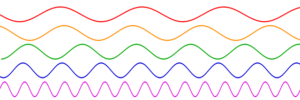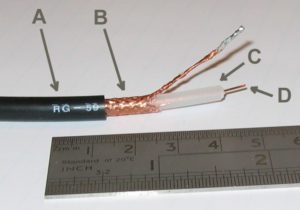What is RF? RF stands for “Radio Frequency” and has become a catch-all term for certain wired communications and a large (spectral) range of wirelessly transmitted waves. It’s easy to find wireless RF modules for microcontroller development kits and other design-ready products, but where does RF cable fit in? What does Ethernet have to do with it? The confusing part about the term RF is that it’s become rather generic and several technologies qualify as RF, both wireless and wired. You might even hear someone talk about transmitting RF signals and not really know if they mean wirelessly or via coaxial cable. As for Ethernet, don’t get mixed up between the term “RF cable” and “coaxial cable.” Many people use them interchangeably, but “RF cable” just means that signals oscillating at radio frequencies (fast) can be contained within RF cable, and that is often what we also call coaxial cable. Other signals that are not RF can use coax, too. Today, a random reference to RF is more likely to mean “wirelessly” since so many more devices communicate wirelessly now.

Radio frequency (RF) signals can be transmitted wirelessly and over an RF cable. Recall that regular AC house current around the world oscillates at either 50Hz or 60Hz. Electrical signals that oscillate at RF frequencies aren’t like DC or AC and can radiate electromagnetic waves at RF frequencies (that’s why they can also propagate through space). RF signals are often encased in a shielded cable (e.g., coaxial cable). Coaxial cable has an outer conducting shield that is typically grounded. The inner conductor is less vulnerable to electromagnetic interference (EMI) and RF signals inside the coax do not radiate outside the coax (especially in an ideal coax/world and if the coax sheath is grounded). Coax can handle signals that run at high frequencies without emanating interference wherever the coax is strung. Coaxial cable is used for transmitting RF signals up to a few gigahertz and is therefore often referred to as “RF cable.” There are RF transmitters and receivers at the end of a coax cable for signals, too. Coaxial cable is used for its relative imperviousness to external EMI and is often used to protect weak signals that are vulnerable to EMI.

But what is meant by RF with respect to wireless communication? The term wireless RF can mean any wave propagating at a frequency of anywhere from 3kHz to 300GHz; a range which defines the entire radio spectrum. Radio waves operate at above infrared on the entire electromagnetic spectrum.
Frequency relates to wavelength, regardless of whether we are talking about signals sent via electromagnetic radiation (wireless) or via cable. (The higher the frequency, the shorter the wavelength.) Coax (used as RF cable) is used in many places, but RF cable is also in the last bit of wireless RF signaling; the transition from wireless to cable is handled by a series of antennas, transmitters, and receivers. One example is a wireless internet router, which has antennas to send and receive RF wireless signals, but there are also coaxial cables with RF connectors on them that connect (and carry) RF signals to a dish antenna or a cable modem from the router.
It can be confusing when people discuss RF signaling. Therefore, it’s beneficial to make the distinction between Wireless RF and RF in general when you communicate about sending signals “over RF.”


Leave a Reply